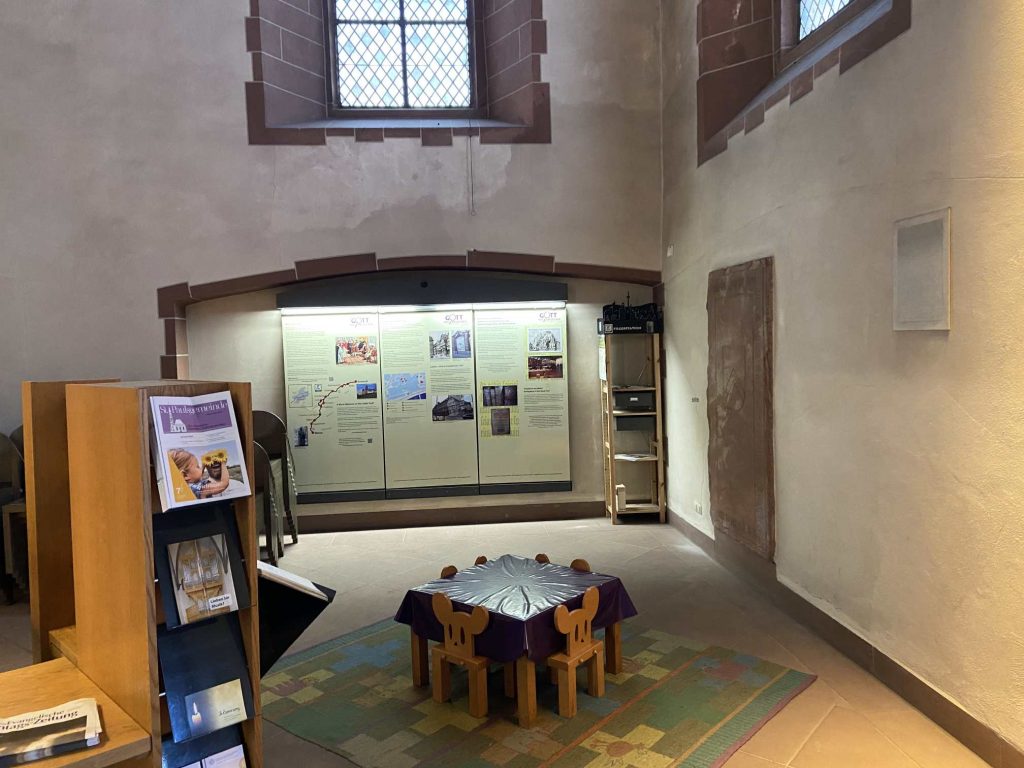(Beginning at the northwest corner)
The three-bayed naves are covered over with square and oblong cross vaults. Ihe middle keystone portrays the bishop Nikolaus, after whom the church is named. Nikolaus of Myra (+350) is remembered as the patron of the sick and friend of the poor, as well as protector from dangers associated with water. By bearing bis name, the church hoped to successfully weather flooding from the nearby Main River.
A large niche in the northwest corner was uncovered during the most recent renovation (1989-1992) . The congregation uses the niche for its „Wandzeitung“ as a means of visibly bringing the Gospel to bear on contemporary issues.
The two gravestones on the southem wall, which were transferred to the Alte Nikolaikirche during the middle of the 19th century, are monuments to the first Lord Mayor, Siegfried zum Paradeis (+1386) and his second wife, Katharina zum Wedel (+1378). Siegfried zum Paradeis is remembered with appreciation for obtaining property for Frankfurt’s Stadtwald. The gravestones were completed around 1410. Other gravestones are dedicated to persons buried in the church, such as the beloved preacher and theologian, Dr. Pritius (1662-1732).
The red standstone sculpture on the southeast wall depicts Christ as the Man of Sorrows. This sculpture, which is a copy of the original on display in the Historical Museum, dates back to 1370.
It draws the observer into deep reflection on Jesus‘ way to the Cross, and calls to mind the words of Scripture: „Surely he has bome our griefs and carried our sorrows; yet we esteemed him stricken, smitten by God, and afflicted. But he was wounded for our transgressions, he was bruised for our iniquities; upon him was the chastisement that made us whole, and with his stripes we are healed“ (Isaiah 53:4-5).
The windows in the sanctuary (south side) as well as in the chancel were designed by the Frankfurt artist, Lina von Schauroth. Charles Engelhard, cousin of the artist, donated the windows in the choir, which were created in 1951. The uniqueness of each Gospel writer is depicted both lifelike and symbolically (cf. Rev.4:6-8).
The windows in the sanctuary were created in the 1930’s for the private chapel of the von Weinberg family in Niederrad.
During the Second World War, the windows were safely housed in the Limburg Cathedral; following the War, they were mounted in the Alte Nikolaikirche.
The chancel or choir is joined to the sanctuary through a pointed curving triumphal arch from a rectangular cross-section. The convex-shaped keystones are decorated with grapes and vine leaves, and rose leaves and blossoms.
The swallow’s nest organ (1992) was built by the Oberlinger firm in Windesheim, together with the Frankfurt organ specialist, Prof. Dr. Menger. Built of Spessart oak, the organ is composed of 23 registers, 1598 pipes, and 25 chimes.









